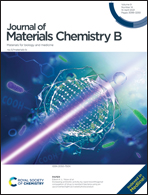Increasing antibiotic activity by rapid bioorthogonal conjugation of drug to resistant bacteria using an upconverted light-activated photocatalyst†
Abstract
Antibiotic vancomycin (Van) is often used as the drug of last resort to treat methicillin resistant Staphylococcus aureus. Due to the emergence of Van-resistant microbes, it is necessary to continuously design strategies to increase the efficacy of Van against resistant cells. In this study, an efficient method of bio-conjugating Van to bacteria is proposed using near-infrared (NIR)-light activation. A Nd3+-sensitized upconversion nanocrystal (UCNC) decorated with toluidine blue O (TB) on its surface undergoes upconverted energy transfer from the UCNC to TB when excited by 808 nm light. The photoexcited TB then catalyses the conversion of the dihydrotetrazine (dHTz) moiety in a Van-dHTz conjugate system to tetrazine which undergoes an efficient inverse electron demand Diels–Alder reaction with prior attached norbornene molecules on bacterial cell walls. The enhanced affinity of Van to bacteria by covalent bonding improves the activity of the drug against drug-resistant Enterococci, and the MIC is reduced by 6- to 7-fold as compared to neat Van. We demonstrate that the mode of action is due to increased inhibition of peptidoglycan cell wall biosynthesis. The findings in this study demonstrate that on-demand NIR-light activated bioorthogonal conjugation of Van to microbes is a viable alternative treatment in combating drug-resistant bacteria.



 Please wait while we load your content...
Please wait while we load your content...